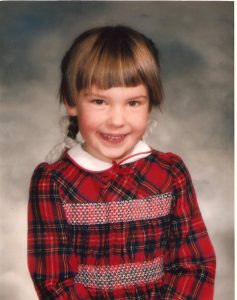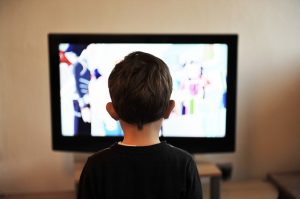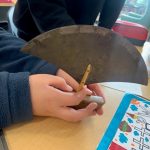
Page 4 of 10
Dear Division 3 and Families,
The end of June is always bittersweet. We say goodbye to friends who might be moving schools, or moving on to high school, and we get nostalgic over the memories and experiences we’ve had together. We are also excited for summer breaks that may be less scheduled and more relaxing, or full of exciting opportunities for exploration and travel. Whatever you are doing this summer, I hope it brings you joy.
Thank you to everyone who has supported our students throughout the school year. Building relationships with students and their families is my absolute favourite part of teaching. When I was working in my district position a few years ago, that was a part of teaching that I really missed. I’ve enjoyed getting to know the students of Division 3–the sports they play, who is in their families, their favourite foods (including the contentious issue of whether pineapple belongs on pizza), their pets’ names and funny antics, and their strengths and passions. While grade 6/7 can be a rollercoaster of a year, I’ve appreciated my time with this group and I’ve been honoured to see how they’ve grown and changed.
I talked about change in my grade 7 leaving ceremony speech, and how embarrassed some students were looking back on the letters they wrote to themselves at the beginning of the year. Through all the groans and eye rolls, Division 3, I hope you can look back at how you’ve grown and changed with pride in your accomplishments. Success isn’t always marked by medals and trophies. It’s in the small victories of handing something in on time, adding more detail to your drawing, or trying something new. Success and growth take courage, and they take time.
“Courage doesn’t always roar. Sometimes courage is the quiet voice at the end of the day saying, ‘I will try again tomorrow. ‘” – Mary Anne Radmacher
Wishing you all the best for a wonderful summer with your friends and families. 🌞
❤ Ms. Coutts
Please enjoy these photos from our year!
Division 1, 2, and 3 have been working hard over three months developing their drama skills. For the past month they have been rehearsing for their reader’s theatre performance of Project Ice: The Ice That Breaks the Night. Our final performance is on Thursday June 8 at 6:30pm in the University Highlands gym. We hope to see you there!
Hi Division 3!

Ms. Coutts in Kindergarten (Did I cut my own bangs? We’ll never know.)
EDIT: We are going to be going in a different direction than what is communicated here. You are no longer required to save photos to your OneDrive.
Division 3 learned the skill of isometric drawing, or isometric projection, which is a graphic representation used by engineers, technical illustrators (drafters), and sometimes architects. Isometric drawing is a technical drawing style that makes two-dimensional figures appear three-dimensional. From Greek for “equal measure,” isometric images can illustrate interiors, exteriors, objects, etc, using height, width, and depth to create the illusion of a 3D perspective.

 Division 3 is learning to identify and reflect on the habits they have with digital media and devices.
Division 3 is learning to identify and reflect on the habits they have with digital media and devices.
From phones and tablets to streaming movies and YouTube, tech and media are everywhere. Kids love easy access to TV shows, games, and information.
Parents and caregivers love that kids can stay in contact while they explore their independence. But it’s easy to overdo it when the phone never stops pinging and the next episode plays automatically.
Check out these tips from Common Sense Media to keep media and tech use in check.
Division 3 was examining how humans have impacted the Earth, and more specifically how we have contributed to climate change. Students were asked to do some research to define what they thought were the top three human contributions to climate change. They in which format to present the information.
One of the skills we have been focusing on is using evidence to support a claim–whether in our responses to reading, drawing conclusions in social studies, or investigating hypotheses in science. With this assignment, students needed to explain the connection between the harmful human activities they identified, and the impact on the climate.
Humans all over the world define our knowledge, values, culture, and worldviews through the language we use. Today Division 3 looked at Inuktitut syllabics and listened to the language.
Inuktitut includes many different dialects, and is written today using two methods: Qaniujaqpait (syllabics) and Roman orthography. Many Inuit communities are working on revitalizing and continuing to teach/learn Inuktitut to maintain traditional knowledge. Inuit use their language to describe places, phenomena, and relationships unique to them. This is reflective of the deep relationship they have with the land, as well as the complex understandings about nature they have learned from their environment. Like in other languages, Inuktitut ties Inuit to their ancestors, family members, and neighbours. It is a way for them to unite and ensure that their cultures endures for generations to come.
Check out some of these games made for children (and really anyone) to develop some understanding of Inuktitut.
Throughout February, Division 3 celebrated Black History Month by researching various individuals of note and summarizing who they are and what they do/did into one to three PowerPoint slides. Students discovered a wide range of Black Canadians that have contributed to our country through sport, politics, art, activism, education, and more.
Students collaborated on a shared PowerPoint file, each person adding their set of slides to the overall composition. Division 3 has been learning how to communicate information effectively. In their slides, their goal was to use visuals and point form to communicate the main ideas clearly.
Please check out their work with this link: Black Canadian Excellence
 Earlier in the school year we talked about how examining artifacts (objects created or modified by humans) can tell us about the society in which they were made and about who used them. Today, students had the opportunity to explore a variety of traditional Inuit artifacts, borrowed from the UBC Museum of Anthropology.
Earlier in the school year we talked about how examining artifacts (objects created or modified by humans) can tell us about the society in which they were made and about who used them. Today, students had the opportunity to explore a variety of traditional Inuit artifacts, borrowed from the UBC Museum of Anthropology.
Students made observations and sketched the objects. They were also tasked with hypothesizing what the objects may have been used for and what materials were used. We have have been developing our understanding of how Inuit have traditionally used resources available to them, especially how the Inuit use(d) seal and caribou. This background knowledge helped us when examining the artifacts.


















































































